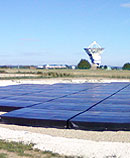Astronomy and Astrophysics
SEPnet-Astro is a collaboration of astronomy centres within six of the SEPnet universities. Combining resources, insight and their own specialist knowledge, the universities are boosting physics in the region across the entire spectrum of astronomy, from planetary science and space science, to astrophysics and cosmology.
PhD Programmes
For information on our Postgraduate Research programmes and SEPnet PhD Scholarships please see here.
Research
As with all SEPnet activity, collaboration plays a key role in our work, particularly between astronomers, cosmologists and space scientists. Research themes are wide-ranging, and include observations, theory and modelling/simulation, on all scales from planetary science in the Solar System, through exoplanets, stars, the Galaxy, the Local Group, and on to galaxies and cosmology.
Earlier and on-going projects and high-performance computing (HPC) resources include:
- Committing research funding to LOFAR-UK to create new radio astronomy facilities in the South East, including the LOFAR radio station at the Chilbolton Observatory
- Supporting the SEPnet Graduate School
- The Sepnet Monitor and Search Machine (SM2) for Chilbolton is a Monitor and Dispersion Search Machine being developed in Oxford.
- The SEPnet Chilbolton All-sky Mapper (SEPCAM) is an All-Sky Imager for LoFAR.
- Chilbolton Support: validation, characterisation, calibration, and aspects of commissioning and local data storage to lead towards a stand-alone option for the Chilbolton LoFAR Station.
- The Portsmouth Cluster: technical support to contribute towards a Computing Cluster available to all SEPnet-Astro members.
- The Institute of Cosmology and Gravitation, University of Portsmouth has commissioning a High Performance Compute (HPC) cluster. The environment will be called “Sciama” (pronounced Shama) standing for “S”EPNet “C”omputing “I”nfrastructure for “A”strological “M”odelling and “A”nalysis . It is a 1008 core, distributed memory cluster using Intel Xeon processors. It will have 85Tbytes of fast parallel storage.
- The Million Source project: funds for computing equipment located in Southampton to allow efficient access to early data from LoFAR surveys.
Want to know more? Visit our network members’ external sites.

